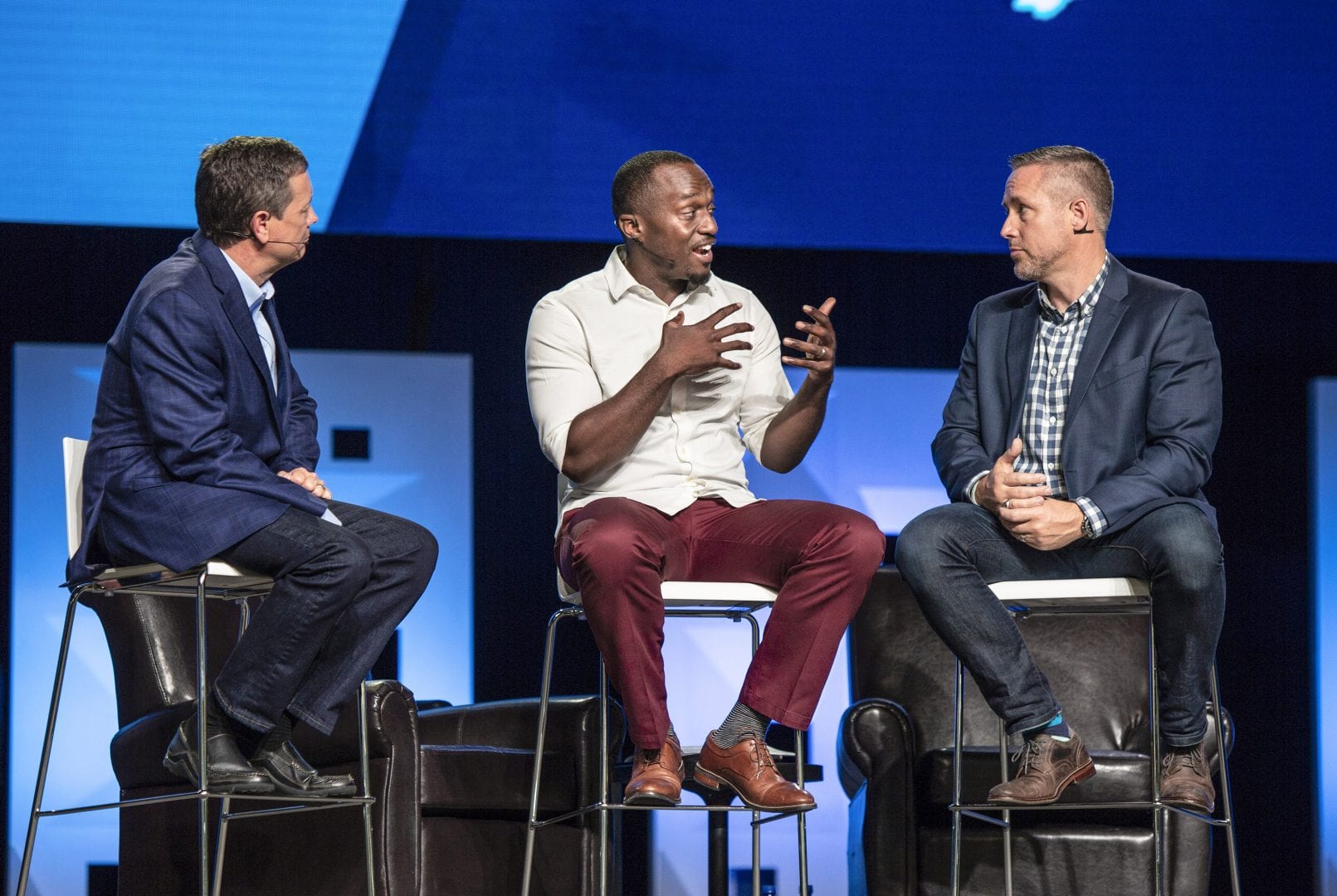
NAMB President Kevin Ezell, left, Dhati Lewis, lead pastor of Blueprint Church in Atlanta and executive director of community restoration for NAMB, and J.D. Greear, lead pastor of The Summit Church in Durham, N.C., and newly elected president of the SBC, discussed the resource “Undivided: Your Church and Racial Reconciliation” June 12 at the SBC annual meeting.
A breakout session on racial reconciliation during the Southern Baptist Convention (SBC) annual meeting accompanied the release of a new resource to help pastors and churches bridge the racial divide in their communities titled “Undivided: Your Church and Racial Reconciliation.”
Those who attended the June 12 session hosted by the North American Mission Board (NAMB) heard a pair of panel discussions centering on the history of race relations in the SBC; current issues that divide different ethnicities; and next steps toward a unified mission.
“As a church, we have an amazing opportunity to display our unity in Christ to a divided world,” said Dhati Lewis, NAMB’s executive director of community restoration. “But to do so, we have to be willing to run into the tension with a heart for reconciliation and address the issues that divide us.
“This is a missional issue,” said Lewis, who also is lead pastor of Blueprint Church in Atlanta. “If we want to make disciples in North America, we must address the issue of race.”
Kevin Ezell, president of NAMB, acknowledged in introductory comments with Lewis, “I’ve been a pastor in the SBC well over 20 years. I’ve been president of NAMB for over seven years. Quite honestly, I’m really tired of talking about [the race issue], having forums and conferences about it and seeing nothing ever change on it.”
Lewis then facilitated the panel discussions before concluding the night in prayer.
The first panel, on the question, “How did we get here?” featured Ed Litton, senior pastor of Redemption Church in Saraland, Ala.; his wife Kathy Ferguson Litton, director of planter spouse care at NAMB; Vance Pitman, senior pastor of Hope Church in Las Vegas; Kevin Smith, executive director of the Baptist Convention of Maryland-Delaware; Jose Abella, lead pastor of Providence Road Church in Miami; and D.A. Horton, pastor of Reach Fellowship in North Long Beach, Calif.
Lewis took the audience through the ideas in a book by George Yancey, Beyond Racial Gridlock, to help the audience understand various secular approaches that have created roadblocks to racial reconciliation: colorblindness, Anglo-conformity, multiculturalism and white responsibility.
Smith, describing the need to extend beyond secular models, noted, “Many models related to dealing with racial reconciliation – social, political, whatever – stem from dealing with the consequences of sin and its results rather than dealing with the plan of God and starting that way.”
The panelists recounted their wide-ranging experiences in dealing with racial issues – from Litton preaching about race in Mobile, Ala., to Abella growing up as an English-speaking Latino in the United States and Pitman being sheltered from racial issues while growing up in rural Alabama.
Horton cited Francis Schaeffer’s book, The Great Evangelical Disaster, to describe the depth of the wounds left by slavery and racism in evangelical Christianity and the SBC. He quoted from 2 Corinthians 7 to emphasize the need for godly repentance and sorrow in order to move forward.
Pittman noted how the church fails its community when it does not reflect its community, and Abella said the church faces a gospel problem when it refuses to reach its neighbors because of cultural and ethnic roadblocks.
The second panel, on the question, “Where do we go from here?” featured J.D. Greear, the SBC’s newly elected president and pastor of The Summit Church in Raleigh-Durham, N.C.; George Yancey, professor of sociology at the University of North Texas; James Roberson, lead pastor of The Bridge Church in Brooklyn, N.Y.; Daniel Yang, director of the Send Institute at Wheaton College; and Jackie Taylor, national MyBLVD urban wives specialist for NAMB’S community restoration team.
Yancey explained the various models he recaps in his book and identified the main issue that each secular model overlooks – human depravity. People readily see the depravity in people they disagree with while “failing to notice the depravity in themselves,” he said, which leads people to demonize those with whom they disagree.
Each of the panelists spoke of how their backgrounds shaped their various perspectives, explaining their hurts, experiences and their input into how believers can move forward, and they described their expectations for the future of the SBC.
Yang emphasized the need for the SBC to fight for diversity as a convention in order to reach a diverse world. He ended the panel discussion by saying of the future of racial reconciliation in the SBC: “I’m optimistic because Revelation has been written already. It’s going to happen.”
The new resource, Undivided, is a free five-week video series featuring Lewis and Greear. Click here to view or download video material and a study guide.
NAMB will publish the content of the breakout session. Follow namb.net for updates.
(EDITOR’S NOTE – Brandon Elrod writes for the North American Mission Board.)
